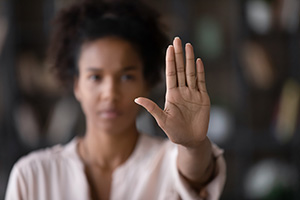News
Domestic Violence
Date: 10/01/22

“Someone I Know is being Abused…”
Someone in the US is abused by someone they love every 15 seconds.[1] Anyone can be in an abusive relationship, regardless of age, race, income, gender, sexuality, or religion. Domestic violence is extremely common – at least 25% of women and 10% of men are estimated to have experienced domestic violence.[2] Since 1981, October has been designated Domestic Violence Awareness Month, to educate and raise awareness about domestic violence, and to let people who have experienced it know they aren’t alone.
Domestic violence can be hard to see, and even harder to break away from. At its core, domestic violence and abuse is about control. The abuser uses physical, sexual, or psychological means – such as making someone feel worthless or isolating them from others – to keep control over someone.2 A person who is being abused may want to believe the abuser can change. Or the situation may be so unsafe that it’s hard to see a way out.
About domestic violence
Domestic violence, also called intimate partner violence, occurs between people who are or have been in an intimate relationship – spouses, partners, and exes. It often begins slowly and gets worse over time. Common types of domestic violence are:[3]
- Physical: Force, such as hitting, slapping, choking, pushing, or beating you, children, or pets
- Verbal: Name calling, insults, putting you down
- Sexual: Forced sex or sexual acts
- Isolation: Prevents or discourages you from going to work or school or seeing family members or friends
- Harassment: Unwelcome phone calls, emails, visits, or stalking
- Economic: Controls money, finances, employment
- Threats: Threats of violence, with or without a weapon; threatens to tell people of your sexual orientation or gender identity
- Jealousy: Extreme jealousy or posessiveness, accusations of infidelity
- Manipulation: Blames you for their violent behavior, tells you that you deserve it, makes and enforces impossible “rules”.
Domestic violence can occur only once, but it often continues over time. Sometimes, the violence will follow a cycle of abuse – apology – abuse, where the abuser seems to have changed their behavior.
How can I help?
If someone you know has experienced domestic violence, there are things you can do to support them. Here are some suggestions:[4],[5]
- Believe them. It’s very rare for people to make up stories about abuse. Make it clear that you believe them and that you are a safe person. Assure them that what happened isn’t their fault.
- Be a good listener. Listen carefully to what they are saying and respond to their feelings as well as their words. Don’t ask for more details than they want to share. Keep what they’ve told you confidential.
- Validate their feelings. They might feel angry or afraid. These are normal feelings! Don’t judge or blame them.
- Let them control their own lives. Don’t try to force someone to do something they aren’t ready to. It’s ok to provide them with information, but don’t try to take control of the situation. They’ve just been through a situation they had no control over, so it’s important for them to make their own decisions.
- Continued support. Be ready to be there for your friend over time. They may need help finding resources or just a shoulder to cry on.
- Help form a safety plan. Survivors are at increased risk when they are leaving an abusive relationship.[6] Help them create a safety plan they can use if the violence occurs again, or they decide to leave. A safety plan should include:
- A safe place to go
- An excuse to use if they feel threatened
- A code word to indicate to friends and family that they need help
- An “escape bag” with money, important documents, keys, toiletries, and a change of clothes
- A list of emergency contacts included trusted family or friends, shelters, and domestic abuse hotline.
For Help
If you need help related to domestic violence, your EAP can refer you to a counselor or to resources in the community. In a crisis, contact a local domestic violence shelter or the National Domestic Violence Hotline
Phone: 1.800.799.SAFE (7233), TTY 1.800.787.3224
www.thehotline.org
Or text “START” to 88788
[1] The Nation's Leading Grassroots Voice on Domestic Violence (ncadv.org)
[2] Harmful Partnerships | NIH News in Health
[3] Domestic violence against women: Recognize patterns, seek help - Mayo Clinic
[4] How to Support Someone who has Experienced Violence - (pridecentervt.org)
[5] How to Help a Victim of Domestic Violence (verywellmind.com)
[6] About Domestic Violence: Barriers to Leaving (umich.edu)
.jpg)
